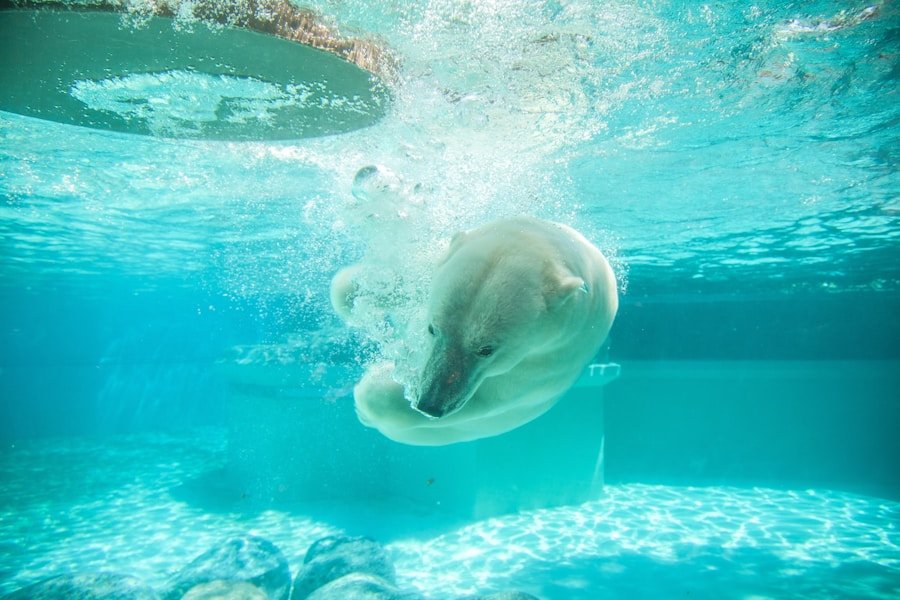When camping, it is essential to have a thorough understanding of wildlife behavior to ensure safe encounters. Different species exhibit distinct behaviors, and recognizing these patterns can help campers avoid potential threats. For instance, bears are attracted to food sources and may become aggressive when they detect them.
In contrast, deer are typically timid and will flee at the first sign of danger. By familiarizing themselves with the behavior of local wildlife, campers can take necessary precautions to safeguard both human and animal safety. In addition to understanding wildlife behavior, it is crucial to recognize signs of potential danger.
The presence of fresh bear scat or tracks, for example, indicates that bears may be in the vicinity. Similarly, unusual noises in the underbrush or sudden changes in bird or animal behavior can signal the presence of a predator. By being aware of these signs and understanding wildlife behavior, campers can take proactive steps to avoid potentially hazardous encounters.
Key Takeaways
- Understanding wildlife behavior is crucial for safely managing wildlife encounters while camping
- Safety precautions such as making noise, carrying bear spray, and keeping a clean campsite can help prevent wildlife encounters
- Responsible food storage and waste disposal is important to avoid attracting wildlife to your campsite
- Keeping a safe distance from wildlife is essential for both your safety and the animals’ well-being
- Respecting wildlife habitats and educating yourself about local wildlife can help minimize negative interactions while camping
Safety Precautions for Wildlife Encounters
Keep a Clean Campsite
One of the most critical safety measures is to maintain a clean and tidy campsite. This involves storing food and waste properly to avoid attracting unwanted visitors. Keep food in airtight containers and store them in a secure location, such as a bear-proof container or a vehicle. Additionally, make sure to dispose of waste correctly by using designated trash receptacles or packing out all trash.
Make Noise While Hiking
Another essential safety precaution is to make noise while hiking or walking through the wilderness. This alerts wildlife to your presence, giving them the opportunity to move away before you come into close proximity. Avoid sudden movements and loud noises, which can startle animals and lead to aggressive behavior.
Respect Wildlife Boundaries
It’s vital to respect wildlife boundaries and never approach or feed them. Feeding wildlife can habituate them to humans, leading to dangerous encounters. Keep a safe distance and observe wildlife from afar, allowing them to maintain their natural behavior and avoiding any potential threats. By following these guidelines, you can ensure a safe and enjoyable camping experience for both humans and wildlife.
Responsible Food Storage and Waste Disposal
Responsible food storage and waste disposal are essential components of safely managing wildlife encounters while camping. Improperly stored food and waste can attract wildlife to campsites, increasing the risk of dangerous encounters for both humans and animals. When camping in areas where wildlife is present, it is important to store all food in airtight containers and keep it in a secure location, such as a bear-proof container or a vehicle.
This can help prevent wildlife from being attracted to the campsite in search of food. In addition to properly storing food, it is also important to properly dispose of waste. This means using designated trash receptacles or packing out all trash to be disposed of properly off-site.
Leaving trash at a campsite can attract wildlife and lead to potentially dangerous encounters. By responsibly storing food and disposing of waste, campers can help minimize the risk of dangerous wildlife encounters and ensure the safety of both humans and animals.
Keeping a Safe Distance from Wildlife
| Wildlife Encounter | Safety Tips |
|---|---|
| Bear | Store food in bear-proof containers, make noise while hiking, and never approach a bear. |
| Coyote | Keep pets on a leash, make loud noises, and do not feed coyotes. |
| Snake | Stay on designated trails, wear closed-toe shoes, and be cautious in rocky areas. |
| Mountain Lion | Travel in groups, make yourself appear larger, and do not run away. |
One of the most important safety precautions for wildlife encounters while camping is to keep a safe distance from wildlife at all times. This means never approaching or attempting to feed wildlife, as this can habituate them to humans and lead to dangerous encounters. It also means giving wildlife plenty of space and avoiding any actions that could be perceived as threatening.
By keeping a safe distance from wildlife, campers can minimize the risk of dangerous encounters and ensure their own safety as well as the safety of the wildlife. In addition to keeping a safe distance from wildlife, it is also important to be aware of your surroundings and stay alert for any signs of potential danger. This means being mindful of fresh tracks or scat, listening for any unusual sounds, and being aware of any sudden changes in the behavior of other animals.
By staying alert and keeping a safe distance from wildlife, campers can reduce the likelihood of dangerous encounters and enjoy a safe and enjoyable camping experience.
Respecting Wildlife Habitats
Respecting wildlife habitats is another important aspect of safely managing wildlife encounters while camping. Wildlife habitats are essential for the survival of many species, and disturbing these habitats can have serious consequences for both animals and ecosystems. When camping in areas where wildlife is present, it is important to be mindful of your impact on the environment and take steps to minimize any disturbance to wildlife habitats.
One way to respect wildlife habitats while camping is to stay on designated trails and avoid trampling vegetation or disturbing natural features. This can help minimize your impact on the environment and reduce the likelihood of disturbing wildlife in their natural habitat. It is also important to avoid making loud noises or engaging in activities that could disrupt wildlife, such as playing loud music or using motorized vehicles in sensitive areas.
By respecting wildlife habitats and minimizing your impact on the environment, you can help ensure the safety and well-being of the wildlife in the area where you are camping.
Educating Yourself about Local Wildlife
Understanding Local Wildlife
By educating yourself about local wildlife, you can take proactive measures to avoid potentially dangerous encounters and ensure your own safety as well as the safety of the wildlife. This knowledge will allow you to anticipate and prepare for potential interactions, making your camping experience more enjoyable and stress-free.
Familiarizing Yourself with Regulations and Guidelines
In addition to learning about local wildlife, it’s essential to familiarize yourself with any regulations or guidelines that may be in place for camping in areas where wildlife is present. This may include rules for food storage and waste disposal, as well as guidelines for interacting with wildlife and respecting their habitats.
Ensuring a Safe and Enjoyable Camping Experience
By educating yourself about local wildlife and familiarizing yourself with any regulations or guidelines that may be in place, you can ensure that you are prepared for a safe and enjoyable camping experience. With the right knowledge and preparation, you can focus on enjoying the great outdoors while minimizing the risk of encounters with wildlife.
Properly Handling Wildlife Encounters
Despite taking all necessary precautions, there may still be instances where campers encounter wildlife while camping. In these situations, it is important to know how to properly handle these encounters to ensure the safety of both humans and animals. If you encounter wildlife while camping, it is important to remain calm and avoid making any sudden movements or loud noises that could startle the animal.
It is also important to give the animal plenty of space and avoid any actions that could be perceived as threatening. In some cases, it may be necessary to slowly back away from the animal while maintaining eye contact and speaking softly in a calm voice. If the animal approaches you, it is important to stand your ground and continue speaking softly while slowly backing away.
It is important to never run from wildlife, as this can trigger their predatory instincts and lead to a potentially dangerous encounter. By properly handling wildlife encounters with calmness and caution, campers can minimize the risk of dangerous encounters and ensure their own safety as well as the safety of the wildlife. In conclusion, safely managing wildlife encounters while camping requires a good understanding of wildlife behavior, taking necessary safety precautions, responsible food storage and waste disposal, keeping a safe distance from wildlife, respecting wildlife habitats, educating yourself about local wildlife, and properly handling wildlife encounters.
By following these guidelines and being mindful of your impact on the environment, campers can enjoy a safe and enjoyable camping experience while respecting nature and minimizing their impact on local wildlife habitats.
FAQs
What are some general tips for safely managing wildlife encounters while camping?
Some general tips for safely managing wildlife encounters while camping include: storing food properly, keeping a clean campsite, avoiding feeding wildlife, keeping a safe distance from animals, and making noise while hiking to alert animals of your presence.
Why is it important to respect nature and wildlife while camping?
Respecting nature and wildlife while camping is important for maintaining the balance of ecosystems, preserving natural habitats, and ensuring the safety of both humans and animals.
What should you do if you encounter a wild animal while camping?
If you encounter a wild animal while camping, it’s important to remain calm, avoid sudden movements, and slowly back away while maintaining eye contact. It’s also important to make yourself appear larger by raising your arms and making loud noises to scare the animal away.
How can you safely store food to prevent wildlife encounters while camping?
To safely store food and prevent wildlife encounters while camping, it’s important to use bear-proof containers or hang food in a bear bag at least 10 feet off the ground and 4 feet away from any tree trunk or branch.
What are some common mistakes to avoid when managing wildlife encounters while camping?
Some common mistakes to avoid when managing wildlife encounters while camping include: leaving food unattended, approaching or attempting to feed wild animals, and not properly disposing of food waste.













